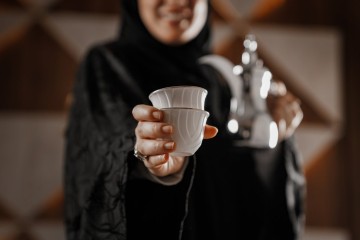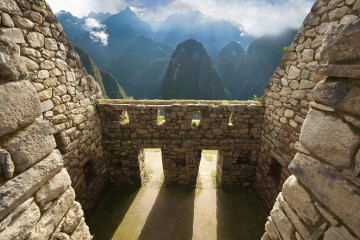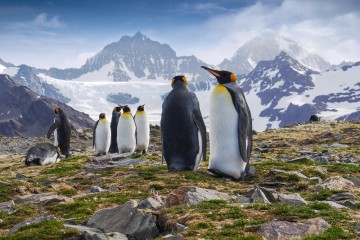Night-sky photography from 40,000 feet in the sky on a moving Air New Zealand dreamliner platform through a small window presents a few unique challenges compared to traditional photography.
There are some issues around how to stabilise your camera, how to focus in the dark, what camera settings to use, how to look with our eyes and photograph through the same window, and whether it’s possible to use your phone camera to capture images.
I’ll address each of these issues individually, but for now I’ll open with just one bit of general advice - get to know your camera! We really can’t over-emphasise how important it is to have an understanding of your camera and lens settings if you plan to take your own photographs on the Southern Lights by Flight.
Click the links below to skip through the article:
1. Adapting to the Dark on the Flight
2. Camera Settings
3. Stabilising the Camera Inside the Cabin
4. Focusing in the Dark
5. Phone Camera
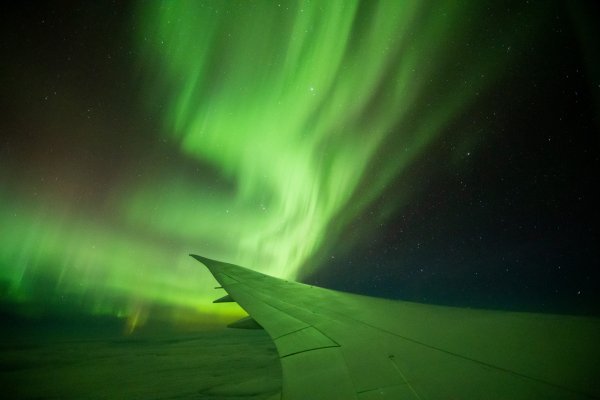
Photo Credit: Brad Phipps | Southern Lights captured with camera
Learn how to put your camera into manual mode (including manual focus), how to turn off the flash, and how to adjust the exposure time, aperture and ISO settings. If you can control these basic settings, then you are 80% of the way there already to capture the night sky and the Aurora Australis. There will have photographers on board all of our upcoming flights who can try to help with these things, but there is a limitation to what can be done, in the dark, with unfamiliar equipment and without the benefit of the user manual in front of us. If you’re not sure how to adjust these settings, read your camera manual now.
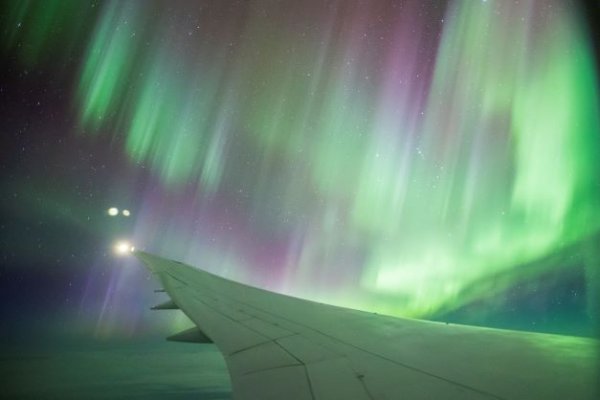
Photo Credit: Brad Phipps | Southern Lights
Adapting to the Dark on the Flight
Before we get into the detail, it’s perhaps also important to think about what your main focus is for the Southern Lights by flight. I’m going to be a little controversial here and say that I don’t think it is possible to take the perfect photo and have the perfect visual experience of the Aurora Australis at the same time.
Taking photos means you will be occupied with many of the things mentioned above, and it will invariably also involve spending lots of time looking at settings and images on an illuminated LCD screen. This will impair your night vision. I cannot over-emphasise this enough - looking at the brightly lit LCD screen of your camera or phone will impair the dark adaptation of your eyes and limit your visual experience.
It takes 20 minutes for the human eye to fully dark adapt, but a glimpse of a bright light or illuminated LCD screen will quickly set this process back by 5-6 minutes. If you keep looking at your LCD screen every few minutes, your eyes will never adjust to the darkness (the equivalent of looking out the window wearing sunglasses for the entire flight!).
The best views of the aurora are only achieved with fully dark adapted vision (and I can guarantee that we will be keeping it very dark in the cabin when we’re in the auroral zone on the Southern Lights by Flight).
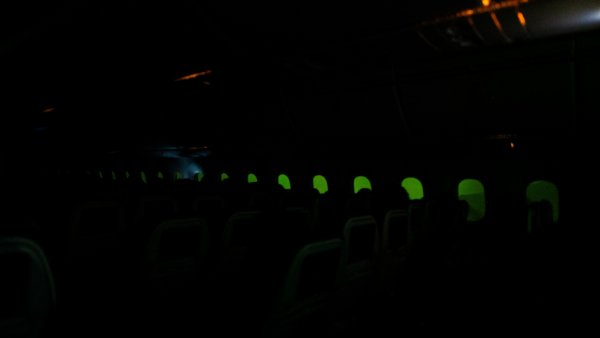
Cabin on the Southern Lights flight
If you really want to maximise the visual experience, then I would suggest putting the phone or camera down, enjoy the views during the flight, and then look forward to the free photos that the onboard photographers will be making available afterwards. If you are going to take photos, try to protect your eyes from unnecessary light - cover the back of the LCD screen, or at least have the brightness dimmed as low as it will go. Turn off “auto-preview” which flashes up a copy of the image each time you take a shot. Another technique is to cover the LCD screen with red cellophane (the dark adapted eye is less sensitive to the effects of red light).
Right, onto the more specific photography advice…
Camera Settings
One of the main challenges photographing the aurora from an aircraft is that we’re on a moving platform. Even during a smooth flight the aircraft is making small adjustments to maintain the correct course and level flight, and this translates to subtle movement of the background sky in relation to our view out the window. An exposure taken while the aircraft alters its pitch or attitude will produce motion blur on your image (particularly noticeable with stars).
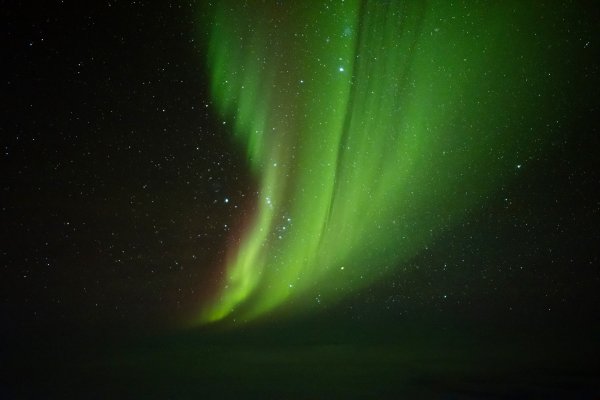
Photo Credit: Stephen Voss | Perfect camera setting for Southern Lights
So the aim is to keep exposures as short as possible to maximise your chance of capturing a crisp static shot with pinpoint stars. This means keeping the lens aperture as wide open as possible, and pushing the ISO (“sensitivity”) setting on your camera as high as you’re prepared to go (the compromise is that higher ISO’s introduce more noise to your images). I usually start out with a pretty high ISO (6400-12800) to capture the first hints of auroral glow, then drop down if/when the display gets brighter. It will depend on your camera however, older cameras may have a more limited ISO range, and they will likely introduce a lot more noise at higher settings.
Apart from very intense displays, most aurora are a relatively faint phenomenon, so exposures of a few seconds are usually required to bring out the detail. A bright auroral display coupled with a fast lens and high ISO may permit exposures as short as 1 second or less, but dimmer displays will need longer (e.g 4-5 seconds). Less sensitive cameras or slower lenses will need even longer exposures, increasing the likelihood of movement blur. To get a feel for what settings are ideal for your own set-up, it can be helpful to experiment taking photos of the night sky in the weeks before for flight, aiming to capture images with a good range of stars showing up in the frame. You’ll need to mount your camera on a tripod, and If you live in a larger city you may wish to travel outside the city boundary away from streetlights on a moonless night to more accurately simulate the level of darkness we will have on the flight. If you can photograph stars from on the ground, then there’s a good chance you’ll be able to at least capture something of the aurora from in-flight.
Stabilising the Camera Inside the Cabin
So we’ve talked about camera settings to minimise the effect of aircraft movement when photographing the aurora in flight, but we also have movement of the camera inside the cabin to combat. We need some way of securing the camera next to the window so that the camera itself doesn’t move while capturing an image. You can try a hand-held shot at high ISO, but the exposure times needed increase the likelihood that your hand will introduce some motion blur.
If you’re fortunate enough to have a camera capable of taking very high ISO video (such as the Sony A7s series), and we encounter a particularly bright aurora on the night, it may be possible to capture some hand-held real time video. But for the rest of us we’re going to benefit from a small tripod, monopod or suction mount to hold the camera steady.
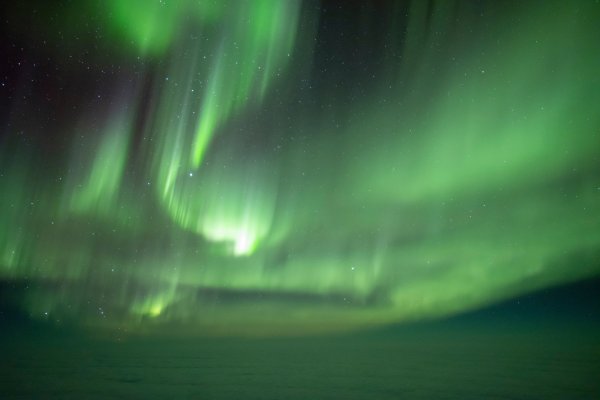
Photo Credit: Stephen Voss
On the first Flight to view the Southern Lights in 2017, I used a small tripod, but space was pretty limited and there was the need for at least one tripod leg to rest on the seat cushion (which itself is not the most stable platform). An alternative is to use a monopod -this is still dependent on providing some manual support to the camera yourself while pushing the lens up close to the window, but a monopod is small, compact and easily deployed without upsetting your seat neighbour. Air New Zealand would prefer that we don’t go scrapping our lens hoods all over their windows and leaving scratches. Sticking some soft adhesive felt around the edge of your lens hood to provide some protection should the lens makes contact with the window would be a good idea. Alternatively, just be careful to maintain a small distance between the lens and the window.
One of the more efficient ways of stabilising the camera inside the cabin is to use a suction mount that attaches to the window and supports the camera. There’s a numerous range of suction mounts available out there, many of them only suitable for lightweight cameras or “GoPro’s”. A full size dSLR and lens can be a bit weighty, so you need to make sure your mount is capable of supporting your own setup.
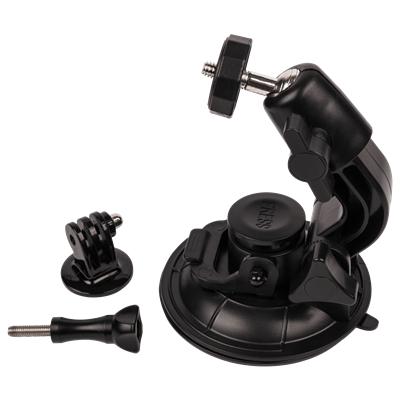
Suction Mount
Suction Mount
Photographers on previous flights have had success with dual or triple mount systems such as those marketed by “Fat Gecko”. Air New Zealand are happy with these devices being attached to the Windows (just not during take-off or landing!). You would need to accept the risk that if we hit a significant pocket of turbulence, there’s a risk that your entire rig may come tumbling down. Also, it’s important that whatever you use, it can be quickly and easily removed when it comes time to seat swap (not a problem if you’ve purchase an entire row between friends), and that it doesn’t impinge on your neighbour.
Focusing in the Dark
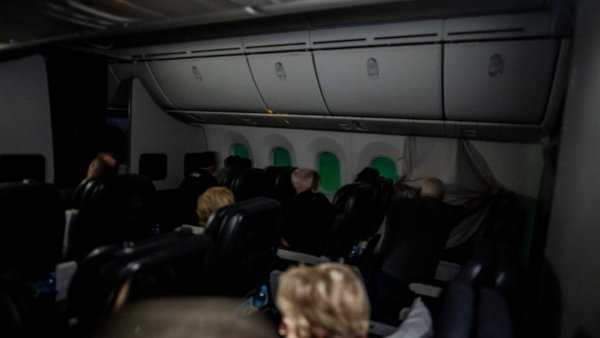
Southern Lights Flight
Photo Credit: Stephen Voss
Trying to achieve accurate focus in the dark can be a challenge. Unless there is a reasonably bright distant object to centre on, it’s likely that the built-in auto focus won’t work and the lens will just whir back and forth trying but failing to find something to lock on. A simple trick is to focus on a distant object during daylight before boarding, then turn off auto focus and hold the lens at that focal setting for the duration of the flight. You can even tape the focus ring in place to prevent an inadvertent knock altering the focus through the night.
If you have a camera with an LCD live view option, this can be especially useful for refining focus manually. Try centering on a bright star then use the digital zoom to magnify the image on the screen. From there you can manually adjust the focus, the aim being to settle on the focal point where the star looks smallest. Again, it’s a good idea to try practicing this from home beforehand without the confined space and more limited field of view of an aircraft seat. And as mentioned above, once you’ve achieved focus, turn off the LCD screen to help improve your own dark adaptation.
What about Phone Cameras?
So one of the most common questions we get asked is “can I take a photo of an aurora with my phone camera”, and there’s no single answer that applies to all the different phones that are now out there. Some phone cameras just don’t have the sensitivity to capture the night sky at all, while there are others that can do a pretty good job using the stock camera app. Whether you have a phone capable of capturing the aurora will depend pretty much on its quality and age. Some of the most recent iPhones and Huawei phones are pretty capable.
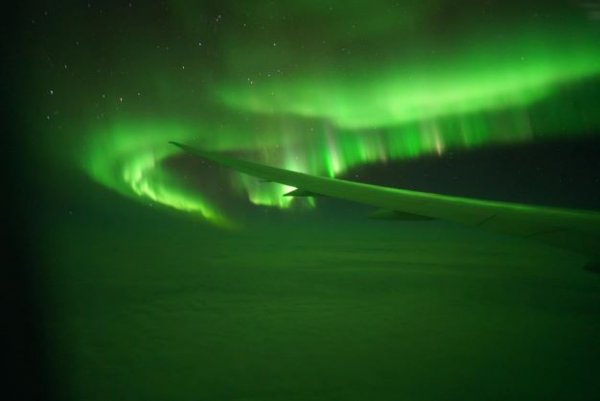
Aurora Australis
Photo Credit: Viva Expeditions
My advice is to try using the stock camera app first - this may be all you need. Just as with the advice above for stand-alone cameras, try taking some photos of stars in the night sky in the days prior to the flight.
If you’re unable to photograph a range of stars, then it’s unlikely that the combination of your phone and the stock camera app will be successful with the aurora.
You could try downloading an app that is tailored toward getting a bit more out of your phone in low light.
For the iPhone a simple option is “Easy Long Exposure Camera” (free download, but paid to be able to get full access to ISO settings) and I’ve also had some success using “NightCap Camera”.
For Android phones I’ve seen some good results from “Manual Camera DSLR” although the interface looks a bit fiddly. Any app that gives you manual control over exposure, ISO and aperture is likely to help.
Learn more about the Southern Lights by Flight.
